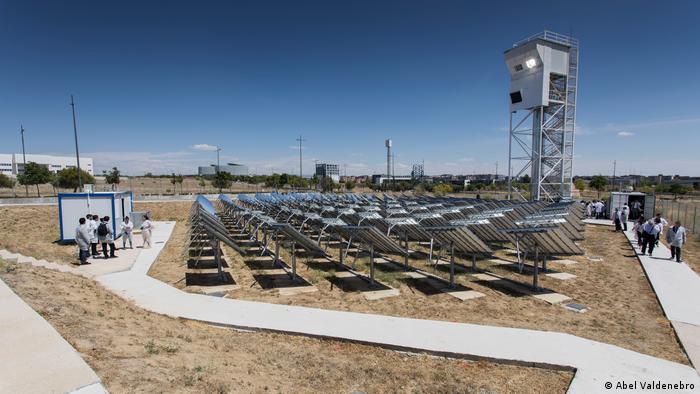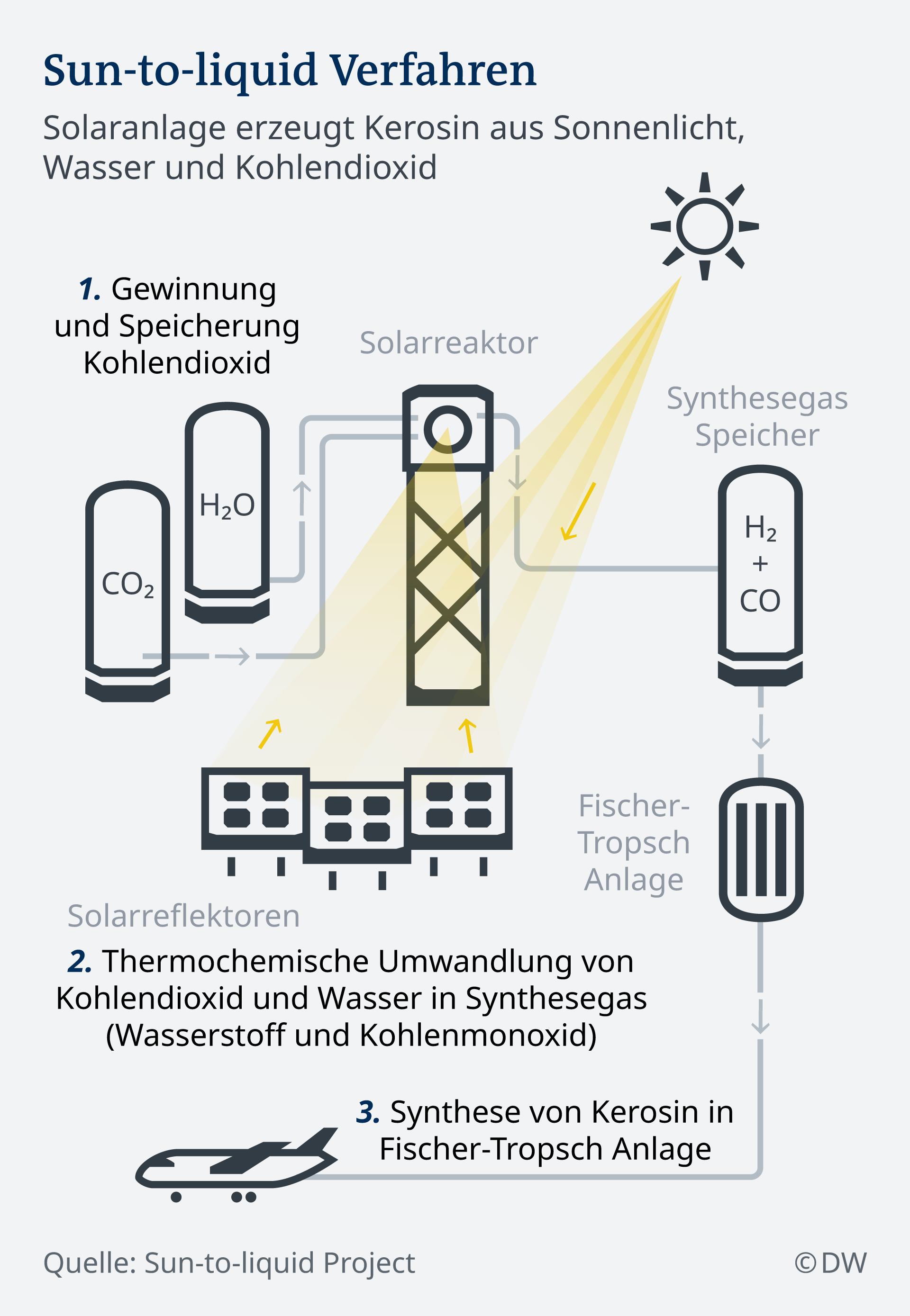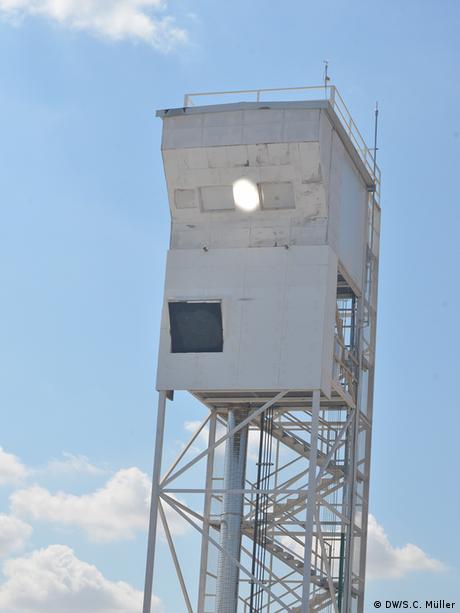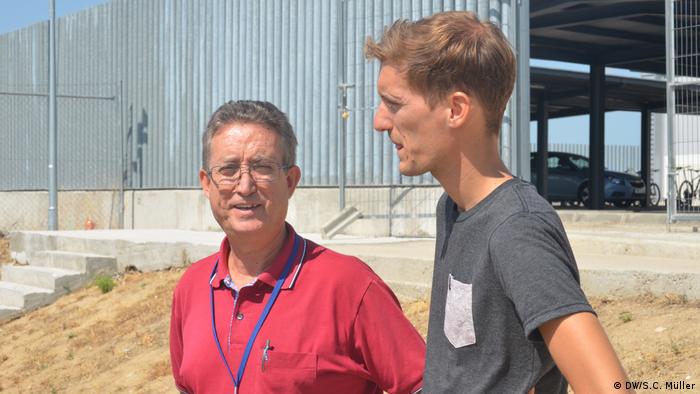In the vicinity of Madrid, the world’s first reactor that produces from the sun, water and carbon dioxide, kerosene works. This is a solution to the climate crisis in the air travel?

Numerous mirrors direct the sun’s rays on the reactor in the tower
Manuel Romero radiates over the whole face. He has worked with in his 60 years at a groundbreaking success, making the chemical engineer proudly. “But I’m only in three years the head of this facility,” he says modestly.
The plant, which he brought with him colleagues from Germany, Switzerland, the Netherlands and Slovenia on the way, in Móstoles, near Madrid. It is the first reactor that produces with solar power and kerosene.
Kerosene is the fuel, the aircraft refueling, and it is particularly harmful to the environment. Therefore, there are already numerous research projects with the aim of kerosene synthetically, i.e. without oil.
The peculiarity in the industrial area of Móstoles: between Shopping Center and car dealer is here made to even a small area for the first time kerosene with solar energy.
Unique in the world
For the industry this is a breakthrough, because “Sun-to-liquid”, as the project is called, is a CO2-neutral solution, the much less resources and land consumed than, for example, Bio-kerosene.
In the case of the combustion in the flight operation synthetically not the cause of produced kerosene variants necessarily have much less pollutants than conventional, petroleum-based kerosene. The difference the production makes.
For Bio-kerosene “must forests be cut down to the raw materials to grow”, says Romero. “In addition, driven by the massive demand for certain crops, the food prices.”

For Sun-to-liquid kerosene, one needs only sunlight, water and carbon dioxide (CO2). The required CO2 will be sucked out of the air, which can be later compensated for in the combustion generated pollutants. The fuel would be carbon neutral.
According to current knowledge, planes and ships can not be driven because of their weight nor electrically. The necessary batteries would be much too big and heavy. On fuels such as kerosene is no way, therefore, for the time being.
No wonder, then, that climate-neutral kerosene is currently attracting a lot of attention. Even from Japan and Croatia, scientists travel to Mostoles, to the Sun-to-liquid-to look at facility.
More than 160 mirror to focus the sunlight onto the reactor, which is housed in a 20-Meter-high tower. The reactor chamber is heated to around 1500 degrees – an unprecedented peak. With the help of a catalyst is generated from water and from the air-extracted carbon dioxide, a synthetic Gas.
Industry in front of a big upheaval
Experts of the civil aviation organization, ICAO, assume that the kerosene demand will rise by 2050 to the six-fold, to around 860 million tons per year. At the same time, the political pressure on our consumption behavior more and more.

By the concentrated solar power leads to temperatures of 1500 degrees Celsius in the reactor
Also, where Romero’s research Institute IMDAE with his reactor, the consequences of climate change significantly. Everywhere in Madrid, the parched and scorched ground into the eye, the well 160 heliostats are falling, those mirror devices which concentrate the sunlight, regardless of the Position of the sun – always to the same point.
“As dry as this year, I’ve experienced it before,” says Romero, who will work until the end of the year with a young engineer at the eidgenössische Technische Hochschule Zürich on this project.
The 28-year-old Stefan Zoller writes his doctoral thesis on the Sun-to-liquid. The ETH Zurich has developed the catalyst in the Solar-reactor, with the aid of the synthetic Gas is produced. The Gas is then liquefied with a according to the German inventors, Franz Fischer and Hans Tropsch named method, hence the term “Sun-to-liquid comes”.
Airlines to investigate on your own
Lufthansa is one of the flight lines, the research already to synthetic Alternatives. With the North German Heide refinery, you produce a research project with wind power, kerosene. This is – as well as Sun-to-liquid in the production, although more sustainable than Bio-fuel, but compared to the conventional kerosene is still not competitive.
The project leader of Sun-to-liquid on the German side, Christoph Falter by the Bauhaus Luftfahrt e. V. expects production costs of about two euros per Liter of kerosene. This is four times as much as the retail price of a traditional fuel oil-based, which is offered for 0.5 Euro per Liter. “This is due to the fact that in the case of this fuel, unlike the gasoline for cars – no taxes are collected,” says Falter.
The Team of Sun-to-liquid hoping that the policy will compensate for the difference in price soon, for example through a tax, by certificate trading or rates for alternative fuels. “If you take into account that the external costs of environmental damage in the case of conventional fuels are not taken into account, there is a good justification for the introduction of such measures,” says Falter.

Manuel Romero, Director of the plant of Mostoles, with PhD student Stefan Zoller from the ETH Zurich
Romero also hopes that the currently expensive technology to suck carbon dioxide from the air, in the next few years cheaper. Thus, the price per liter of synthetic kerosene would be reduced.
Sure seems to, at least, that Romero will not run out of work so soon. The world’s first solar thermal plant in Seville, he worked at the time. And solar installations are booming in Spain as never before.
Spain’s Solar Boom
According to the Spanish industry Association UNEF were installed in the past year 261,7 MW of new photovoltaic electricity. This corresponds to an increase of 94 percent compared to 2017.
German and Spanish have been working together for decades. The German center for air and space travel (DLR), which is also involved in the project Sun-to-liquid, a Solar research station in Almeria.
“Spain is an attractive location in Europe, since the place is a sun-rich, in a stable environment with relatively favorable conditions for investment financing”, confirmed the Moths of the Sun-to-liquid.
Also, the German technology company, Kaiser weather on the Iberian Peninsula, here it’s sold mainly Monitoring systems. Hanno Schoklitsch, CEO and founder of glorious weather, keeps the Sun-to-liquid is also a milestone: “It is a key for a more sustainable mobility, but also on the sea.”
Manuel Romero, the chief of the Sun-to-liquid facility, is pleased: “For me it is the culmination of my career as a scientist, and for this reason alone, I am European. Because without the seven-million euros EU-funding and the cooperation of so many experts, this success would not have been possible.”